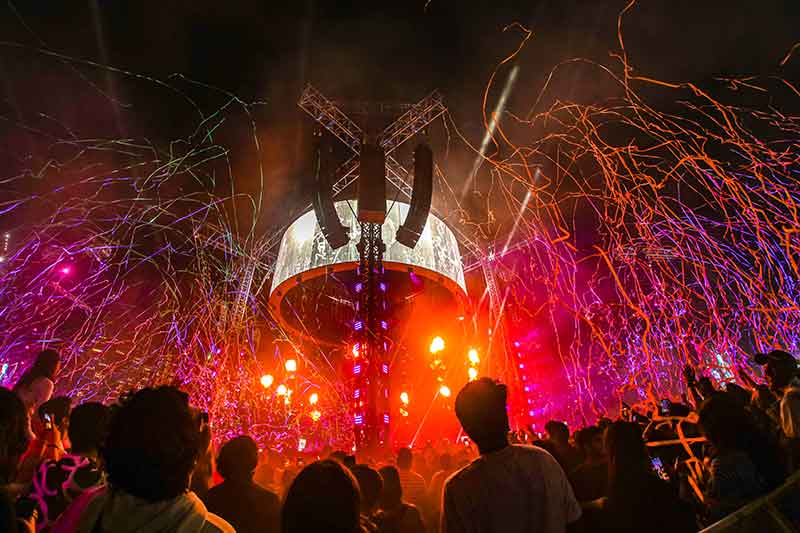Since kicking off his tour in Dublin in April 2022, Ed Sheeran has taken his + – = ÷ x (Mathematics) Tourto more than 100 cities around the world, wowing millions of fans along the way with his now-iconic one-man, in-the-round production. The English singer-songwriter wrapped up the Middle East and Asia leg of the tour in March at Mumbai’s Mahalaxmi Racecourse, with his production team linking up with Major Tom and Meyer Sound, along with India-based distributor Sun Infonet, and sound equipment suppliers, Total Multimedia, Phoenix Networks, Friends of Shiva, and PP Sound, to deliver an unforgettable sonic experience.
Despite Mumbai being the only Indian show on the run Middle East and Asia leg, the Sheeran camp opted to bring the scaled in-the-round show, with the main sound system centred around a box truss with two 16-box Meyer Sound PANTHER arrays flanking 10 1100-LFC low-frequency control elements flown from each corner, with the stage system of 22 LEOPARD loudspeakers and 18 1100-LFC control elements on the ground.
While freighting restrictions meant that the PA had to be sourced locally, Ed Sheeran’s Production Director, Chris Marsh, explained how the availability of PANTHER in India meant that the tour’s signature sound could be maintained in Mumbai. “Having PANTHER available in India ticked so many boxes. It is our system of choice; we know it so well and are confident of its abilities,” he commented. “Knowing that we could deploy this system meant that audio was not a concern at all,” he adds. “It also meant that we did not need to use delays which had formed part of other vendors’ designs. This was a financial saving, as well as one less logistical element to deal with.”
Collaborating closely with Sun Infonet, Marsh, and Systems Engineer Adam Wells, the team seamlessly integrated the PANTHER system into the show’s setup, working out mapping and routing well in advance using MAPP 3D – which Marsh described as “an essential tool” in getting the message across when agreeing on box counts and quantity of hangs.
“The visual aid and the universal language used in this software bridges any barrier, and it was easy for the local team to understand our design,” Marsh noted. “Our task was made even simpler by Meyer Sound allowing us to borrow back our old systems engineer, Charlie Albin [now Meyer Sound’s Technical Support Specialist, UK], who came and oversaw the installation with the local team,” he added.
Sun Infonet’s tech team was led by Jeremy Rana, Kallol Nath, and Jayakaran B; Animesh Mishra of Phoenix Networks, Anuragg Jai of Total Multimedia, and Kyle Mukerjee of Friends of Shiva were also key collaborators.
For Phoenix Networks founder and Director, Animesh Mishra, the project had his team “exploring the various complexities of mathematics and physics like never before,” he laughed. “It was both a challenge and a thrill. From the start, we knew that crafting an immersive audio experience would take a mix of creativity and technical know-how. We encountered numerous challenges, but each obstacle we faced only made us more determined to exceed expectations and give the audience something truly unforgettable.”
Phoenix Networks took the reins of planning, designing, and deploying the Meyer Sound system. The main rig comprised a total of 128 PANTHER line array modules, with two hangs of 16 boxes suspended on each of the stage pillars at a height of 17m and inclined at a precise angle of 6° downwards. An additional configuration of 12 80° long-throw PANTHER line array modules at the top of the array and four 110° wide-throw PANTHER line array modules at the bottom was also deployed to cover both long and wide spans of the venue.
In addition to the main rig, 22 LEOPARD line array modules were positioned strategically around the circular stage for front fill reinforcement, with a further 16 LEOPARD boxes deployed in stacks of two per pillar as in-fill. Low end meanwhile was covered by four suspended arrays of 10 1100-LFC subwoofers at a height of 16.5m, with an additional six clusters of three 1100-LFCs ground-stacked.
Processing was handled by 12 Galileo GALAXY 816 units, with two allocated to each audio tower and three at FOH. The signal routing was primarily managed through Luminex’ GigaCore 26i switchers.
Mishra discussed the rigging challenges brought about by the size of the production. “Rigging the system on a cantilever at significant heights and steep angles presented a unique set of hurdles,” he recalled, adding that an analysis using MAP3D software revealed an intricate set of requirements and precise measurements and angles. “Bear in mind that these precise measurements were pivotal to achieving optimal coverage and dispersion,” he noted.
“This concert exemplifies the transformative power of dedication and hard work,” Mishra continued. “It’s a testament to what can be achieved when creativity and technical expertise come together. We’re immensely proud to have been a part of this project and to have played such a crucial role in creating such a magical experience for the audience.”
For Meyer Sound’s Director of International Sales, Scott Gledhill, the Mumbai show was “a testament to seamless sound delivery, thanks to the collaborative efforts of the crew, Meyer Sound, and Sun Infonet”. He concluded: “Continuing to set the standard for innovative live sound production, and making it happen around the world is at the core of what we do, and our international partners are integral to that success.”
The Mathematics Tour will continue into the summer, returning to a full production of 14 PANTHER arrays. “PANTHER has performed perfectly for us for two years now,” Marsh stated. “We have no intention of changing anything.”
Photos: Meyer Sound





